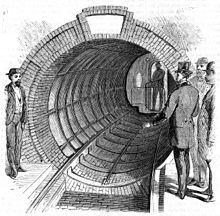Beach Pneumatic Transit
| Beach Pneumatic Transit | |||
|---|---|---|---|

Sketch of the train car and tunnel
|
|||
| Overview | |||
| Type | Atmospheric railway | ||
| Locale | New York City, United States | ||
| Termini | Warren Street and Broadway Murray Street and Broadway |
||
| Stations | 1 | ||
| Operation | |||
| Opened | February 26, 1870 | ||
| Closed | 1873 | ||
| Owner | Beach Pneumatic Transit Company | ||
| Operator(s) | Beach Pneumatic Transit Company | ||
| Rolling stock | 1 car | ||
| Technical | |||
| Line length | 95 m (312 ft) | ||
| Number of tracks | Single track | ||
|
|||
The Beach Pneumatic Transit was the first attempt to build an underground public transit system in New York City. It was developed by Alfred Ely Beach in 1869 as a demonstration subway line running on pneumatic power. As the subway line had one stop and a one-car shuttle going back and forth, it was merely a novelty and not a regular mode of transport. It lasted from 1870 until 1873.
Alfred Ely Beach demonstrated a model of basic pneumatic subway system, in which air pressure in the tube pushed the cars, at the American Institute Exhibition in New York in 1867. After demonstrating that the model was viable, in 1869 Beach and his Beach Pneumatic Transit Company began constructing a pneumatically-powered subway line beneath Broadway. Funneled through a company he set up, Beach put up $350,000 of his own money to bankroll the full-scale test project. Built with a tunneling shield, the tunnel was complete in only 58 days. Its single tunnel, 312 feet (95 m) long, 8 feet (2.4 m) in diameter, was completed in 1870 and ran under Broadway from Warren Street to Murray Street.
However, one of the city's top politicians of the day, William "Boss" Tweed, would not support such a project. With no initial political support for the project, Beach started the project by claiming he was building postal tubes. The initial permit was to install a pair of smaller postal tubes below Broadway; however, Tweed later amended the permit to allow the excavation of a single large tunnel wherein the smaller tubes could reside. The exact location of the tubes was determined during construction by compass and survey as well as verified by driving jointed rods of iron up through the roof of the tunnel to the pavement. The line was built as a demonstration of a pneumatic transit system, open to the public with a 25-cent fare per person. Proceeds for the admission went to the Union Home and School for Soldiers' and Sailors' Orphans. It was planned to run about 5 miles (8.0 km) in total, to Central Park, if it were ever completed.
...
Wikipedia

